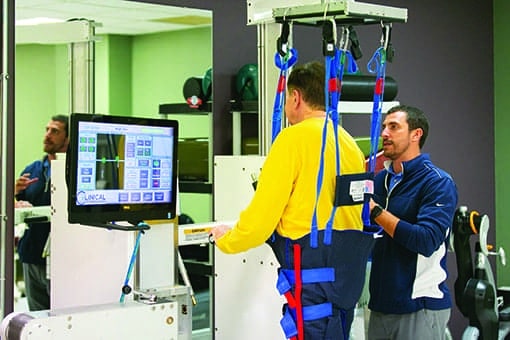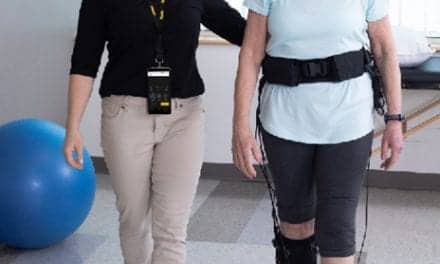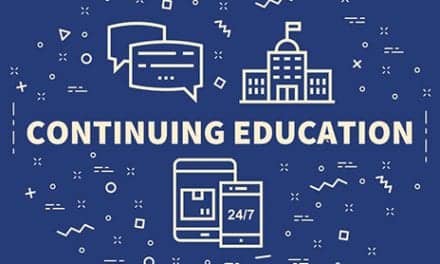
Under therapist supervision, Greg Myers uses a treadmill device that places him in a standing position as robotics assist his legs to walk on a treadmill. Sensors continuously monitor walking patterns, changing power and speed according to Myers’s mobility.
by Meri K. Slaugenhaupt, MPT, and Valerie Bucek, MA, CCC-SLP/L
According to the Centers for Disease Control and Prevention, someone in the United States has a stroke every 40 seconds. Someone dies from a stroke every 4 minutes. It is a leading cause of long-term disability. A stroke occurs when there is a disruption in blood flow to the brain. The most common kind of stroke, ischemic stroke, occurs when a clot or mass obstructs a blood vessel. A hemorrhagic stroke occurs when a weakened blood vessel ruptures.
This article follows the treatment of stroke survivor Greg Myers, who was finishing his workday when he suddenly became confused and had difficulty walking and talking. A co-worker called Emergency Medical Services, and Myers was transported to the nearest acute care primary stroke center for treatment. Myers had suffered a right cerebellar hemorrhage. His hospital course was complicated by the need for evacuation of the hematoma, post-occipital craniotomy, and wound dehiscence. After several days of acute medical care and monitoring, it was determined that Myers would benefit from intensive multidisciplinary rehabilitation services to address his residual physical deficits and cognitive needs. To begin his stroke rehabilitation journey, Myers chose HealthSouth Harmarville Rehabilitation Hospital (which will be known as Encompass Health Rehabilitation Hospital of Harmarville beginning January 1, 2019).
Evidence-Based Rehabilitation
Since 2002, HealthSouth Harmarville has been certified as a Joint Commission Disease-Specific Care Stroke Program. The team follows evidence-based Clinical Practice Guidelines (CPG) for treatment of individuals with stroke. By following these guidelines, the team has confidence that treatments are based upon the most current evidence-based research and philosophies.
Comprehensive rehabilitation services, such as those provided at HealthSouth Harmarville, are found to be one of the most effective ways to achieve functional recovery and independence after a stroke. Intensive rehabilitation services facilitates neuroplasticity and recovery of motor function. Neuroplasticity is the ability for the brain to “rewire” or adapt to new circumstances by reorganizing synaptic connections. By engaging in therapy that is challenging, repetitive, and task specific, motor pathways that have been disrupted by the stroke can be rewired and strengthened.
Reducing Complications of Stroke
One of the goals of the clinical practice guidelines is to reduce the complications of stroke. One of the most frequent complications following a stroke is difficulty swallowing, or dysphagia. Stroke survivors with dysphagia have an increased risk of pneumonia, dehydration, and malnutrition. Instrumental assessment in the form of a Modified Barium Swallow study (MBS) or Fiber-Optic Endoscopic Evaluation of Swallowing (FEES) determine an appropriate, safe diet and the course of treatment. Swallowing difficulty is treated by exercise, diet modification, and technology, such as neuromuscular electrical stimulation.
Early therapy intervention is also important to maximize motor recovery in our stroke patients. Deconditioning and non-use are a hurdle to restoring function, especially with the elderly stroke population. Physiological changes and complications as a result of prolonged bedrest can lead to additional loss of muscle mass, contractures, skin breakdown, and deep vein thrombosis, all of which further hinder the stroke-recovery process.
Technology and the Path to Walking
Being able to walk again is a common goal shared by most stroke survivors, and Myers was no exception. Studies show that stroke affects mobility in greater than half of stroke survivors. Those suffering from gait disturbances often have further difficulties with balance and cardiovascular endurance, and are subsequently more likely to fall. Therefore, improvements achieved with gait function frequently carry over to improvements in many other aspects of daily living.
In the past decade, technology has moved to the forefront of therapeutic intervention as an adjunct to conventional practice. This is true for all disciplines and ranges from Vital Stimulation in the treatment of dysphagia to robotics in the treatment of movement disorders.
Body weight-supported technology is one such area of technological advancement being utilized for gait training. Partial body weight (PBW)-supported devices are designed to use a harness and/or suspension system to assist with standing and safety during ambulation. When partial body weight devices are used over a treadmill, the therapist is able to change gait speed and work on gait quality under controlled, safe conditions. However, many PBW devices do not require use of a treadmill and can be used over the ground while providing similar training benefits to patients.
Automated technology incorporates the use of robotics, using attachments to the patient’s hip, knees, and ankles. These robotics guide the patient’s lower-extremity movement and promote normal movement throughout the entire gait cycle. Robotic body weight support is generally used with more involved patients who have significant difficulty with lower extremity movement. These devices allow the therapist to gradually decrease the support provided as gait improves.
Fall Protection and Balance
A clinical advantage that these technologies have over other conventional gait training is the reduced support required by the therapist. When asked about using a PBW support device, Tammy Whitlinger, a physical therapist assistant at HealthSouth Harmarville for 28 years, states, “I am able to safely initiate gait training earlier, and my patients are less anxious about the training because they know that they can’t fall.”
Balance deficits resulting from a stroke can also be very debilitating and frustrating for individuals. Since Myers had a stroke that affected the cerebellar part of his brain, balance training was also a major component of his therapy program. Myers’s balance program included a variety of approaches including altering visual feedback and multi-surface challenges. Equipment utilized for balance deficits can be as simple as carpet or foam. More complex devices are designed to use interactive technology and visual feedback to further analyze a patient’s posture and balance deficits.
Treadmills are another piece of technology commonly found in the clinic that are used to improve motor recovery after stroke. Treadmill training can be used with or without partial body weight support. When used along with conventional therapy, treadmill training has been shown to improve gait quality and efficiency, strength, and cardiovascular fitness. Other adjunct modalities are also utilized by physical therapists to address aerobic fitness and reciprocal movements of the lower extremities, such as stepper machines, elliptical trainers, and stationary/recumbent bikes.
Upper Extremity Dysfunction
Advanced technology used for the treatment of upper extremity dysfunction has also impacted stroke rehabilitation. Improving deficits in fine motor control, coordination, and weakness are often a focus of treatment in stroke recovery. Electrical stimulation, biofeedback, or robotics are utilized in many technologies to retrain arm movements and hand function. Some of these devices are even coupled with gaming to provide motivation and entertainment for the patient while exercising.
Family/caregiver involvement early on is very beneficial to a successful inpatient rehabilitation stay and transition to home. Our Clinical Practice Guidelines recommend that patients and caregivers be educated throughout the entire stay to learn about disease process, expected outcomes, treatment goals, and follow-up support services available in the home and community. As part of our discharge planning and preparation for a safe transition home, we completed a home visit for Myers. This is when the physical and occupational therapist team takes the patient home in order to problem-solve accessibility issues and to perform caregiver training in their own environment. By doing this, Myers and his wife were less anxious and fearful about their transition home.
Neuro-Focused Outpatient Rehab
Quality inpatient rehabilitation is a vital step in the journey of returning to community participation. Many patients choose to receive home health services after inpatient rehabilitation to assist with the transition to home. Myers briefly utilized home health before initiating the next stage of his recovery, which was a neuro-focused outpatient program found at HealthSouth Harmarville. Outpatient therapy provides an opportunity for stroke survivors to build endurance and to practice skills in higher levels of difficulty. Concerns and issues that have arisen from community integration can be incorporated into treatment and resolved. Instrumental activities of daily living are also a focus of the outpatient program. Participation in activities such as disease-specific support groups and wellness programs can help to facilitate return to the community.
HealthSouth Harmarville offers the entire continuum of care for patients, ranging from inpatient rehabilitation to home health to outpatient services to community support groups. Myers’s wife, Cathy, has become an active participant in the hospital’s Stroke Support Group, attending the educational programs and interacting with families of other stroke survivors. Myers, himself, continues to make gains in physical functioning, daily living skills, communication, and cognitive skills in outpatient therapy. He has returned to some of the leisure activities he enjoyed before his stroke. The couple took another step toward normalcy by going on a vacation to Aruba in August.
Additionally, Greg Myers was honored at the hospital’s National Rehabilitation Awareness Week celebration in September as one of five Rehab Champions treated in the last year who displayed determination, a positive attitude, and the ability to overcome obstacles in order to be successful. RM
Meri K. Slaugenhaupt, MPT, has served on the HealthSouth Harmarville Rehabilitation Hospital team since 1993, beginning as a physical therapist and now serves as the team’s program champion of the stroke program. In this role, Slaugenhaupt has obtained Stroke Joint Commission Disease Specific Certification, making HealthSouth Harmarville the first rehabilitation hospital to achieve this status in 2002. Under Slaugenhaupt’s leadership the hospital has achieved its 8th Joint Commission disease-specific care certification in 2017 for the stroke program. She earned her bachelor’s degree in physiology with a minor in exercise science from Penn State University in 1991. She then earned her master’s in physical therapy at the University of Pittsburgh.
Valerie Bucek, MA, CCC-SLP/L, has been a member of the HealthSouth Harmarville Rehabilitation Hospital team for more than 25 years. She began her work there as a staff speech pathologist and a speech therapy supervisor prior to her current role as the hospital’s therapy manager. Bucek received a bachelor’s degree in speech pathology from Duquesne University and a master’s degree in communication disorders from the University of Pittsburgh. She is one of the leaders of the hospital’s stroke and Parkinson’s disease programs, is founder and facilitator of the HealthSouth Harmarville Community Stroke Support Group, and is an affiliate for the ASHA Special Interest Division-Adult Neurogenic Communication Disorders. For more information, contact [email protected].





I like how you said that most stroke survivors wish to be able to walk again. I think this is a beautiful goal and I think doctors should try everything to help these people achieve it. It would be great to see them walk again after fighting so hard for it.
Technology has brought so many innovations in the medical field, I’m glad humankind is benefiting from it rather than focusing on making deadly weapons.